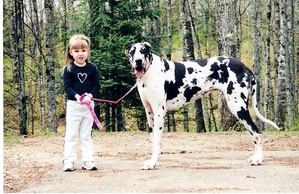Descended from the extinct old English bulldog and Manchester terrier, the bull terrier was originally bred to help control vermin and to fight in the blood sports of bull and bear baiting. Today’s iteration looks as different as it behaves. With its distinctive egg-shaped head due to the lack of stop, the area between the eyes and across the bridge of the nose that typically leads to frontal facial features of the dog, the bull terrier is very recognizable.
The original cross was brought about to increase fighting prowess – the lighter, more agile terrier build combined with the tenacity of the bulldog made it a formidable foe. Various combinations of bulldogs and terriers also created other pit-fighting dogs such as the pit bull and Staffordshire terrier. However, the bull terrier eventually was crossed with Dalmatian, greyhound, Spanish pointer, foxhound, whippet, borzoi and collie. The first modern version of the bull terrier, one that lacked any stop at all, is credited as Lord Gladiator and is dated 1917.
While their history resides in the blood sports, the originator of the breed, James Hinks, sought a more refined companion. To this day, the bull terrier carries a cavalier attitude – not ...









